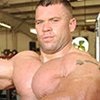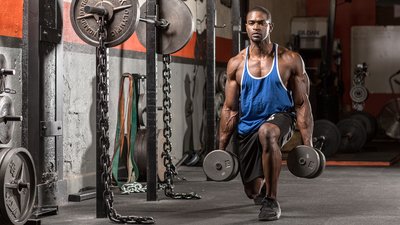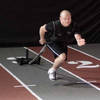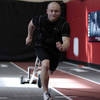Day in and day out, I deal primarily in strength: Big numbers, piles of plates, and results that are proved in competition. But when my editor at Bodybuilding.com charged me with a hypertrophy-focused leg workout, my eyes lit up. I've always wanted to goose one of those machine-lovin', middlin' weight-and-rep schemes designed for selfie-snapping aesthetic warriors.
Instead of a 3-sets-of-10, 1990s-style "Muscle and Fitness" workout, I was intent on building something far more effective and a helluva lot more fun. You might be surprised to see that the only squats you'll be doing are of the bodyweight variety, at the very end of the routine. But trust me, you'll get all you can handle!
Here's what I came up with, along with my tips to get the most out of each movement.

BodyFit
$6.99/month- 2,500+ expert-created single workouts
- 3,500+ how-to exercise videos
- Detailed workout instruction
- Step-by-step workout tips
- Training at gym or at home
- Access to Workout Plans
- Access to Bodyfit App
- Store Discounts
Already have a Bodybuilding.com account with BodyFit? Sign In

What comes with BodyFit?

- Instructional Videos
Don't risk doing a workout improperly! Avoid injury and keep your form in check with in-depth instructional videos.

- How-to Images
View our enormous library of workout photos and see exactly how each exercise should be done before you give it a shot.

- Step-by-Step Instructions
Quickly read through our step-by-step directions to ensure you're doing each workout correctly the first time, every time.
1. Backward Sled Pull
Very few people know that the year before bodybuilding legend Branch Warren won his pro card in 2001, he quit squatting and started sled pulling. Why? Because he knew that backward sled pulls would take the size and strength of his quads to the next level. With the right mix of volume and intensity, they'll also take you straight to the depths of anaerobic hell. What a way to start!
Besides blasting your quads and proving your mettle, this movement will test the strength of your torso and grip. Moreover, you'll get a boost in conditioning and decrease excess body fat.
Key Training Tips
- Never let the sled stop! Think back to high school physics class. It takes more energy to get an object moving than to keep it moving.
- Never row the weight. Keep in mind your arms are your weak link, not your legs. Lean your torso back, and think of your arms as hooks that don't move.
- When pulling the sled, make sure you're taking fast, short, choppy steps. Unlike traditional sprints, long strides will slow you down. Since the goal is to go heavy, producing maximal force is critical; you'll apply more force with small steps.
- Do not pace yourself. Start heavy, and reduce the weight as needed.
- If your gym doesn't have a sled, do 5 sets of 5 front squats with a weight you're capable of doing for 7 reps. Rest 120-150 seconds between sets.
2. Leg-Curl Cluster Set
For decades, one of the go-to movements for bodybuilders to build the hamstrings has been the lying leg curl. It still is, and for good reason—it works!
Your hamstrings are composed of primarily fast-twitch muscle fibers, so for growth and performance, they'll respond best to lower reps. This is why sprinters have such amazing hamstring development. Bodybuilders, on the other hand, don't normally train hamstrings heavy with lower reps and often leave growth on the table.
We're going to remedy this with cluster sets. Cluster sets simply mean more sets of fewer reps. As I explained in "Build Massive Arms With Cluster Sets," I like to use a clock to guide my cluster sets. Here, you'll use the same weight you'd use for sets of 10, but only do sets of 3 with 15 seconds of rest. You'll get a helluva lot more volume in not much time!
Key Training Tips
- Ideally, you'll use a leg-curl machine that's angled instead of a flat bench, since an angled one is better for optimal hamstrings recruitment. No matter what you use, make sure you adjust it for your height.
- On the positive portion of the rep, lift the weight explosively but under control. Use a controlled eccentric of approximately two seconds.
If the leg-curl stack just isn't quite heavy enough, or you just have the yearning desire to try something new, give eccentric Nordic leg curls a shot. New York Mets pitcher Noah Syndergaard, who throws a fastball just under 100 miles per hour, makes these look easy even with a five-second eccentric.
3. Romanian Deadlift
If you're doing only leg-curl movements for hamstrings development, you're losing out on a lot of rear-thigh growth. Because the hamstrings cross both the hip and knee joints, you need to train both knee flexion and hip extension to maximize them. For hip extension, this move is as good as it gets.
I prefer to start RDLs standing upright after picking the barbell up off the power rack. If you don't have one, deadlift the weight off the floor. Take a stance between hip and shoulder width, grasping the barbell with your hands just outside your thighs with an overhand grip.
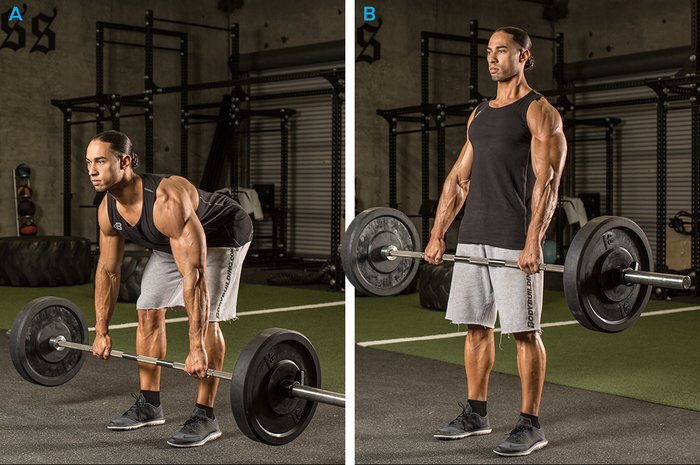
Romanian Deadlift
Key Training Tips
- Keep the bar in close to your body and your back flat. The further it drifts away from you, the more stress will be put on your lower back. If you have back issues, consider staying away from this move.
- Perform this movement heavy, but never at the expense of sacrificing technique or tension. Romanian deadlifts can also be performed with dumbbells.
- If you want to try something different, try the single-leg version of this movement. Besides the typical unilateral benefits, it builds balance. The single-leg version smokes the hamstrings and can be done with dumbbells or a barbell.
4. Walking Lunge
Metroflex gym owner Brian Dobson says the walking lunge has now become standard for upper-leg separation and glute-ham tie-in. This wasn't news to Ronnie Coleman. In his prime, the eight-time Mr. Olympia did walking lunges with 405 pounds for 50 yards!
Aside from their leg-development power, lunge variations also strengthen the core and increase stability for heavy squatting. So even though you're not doing heavy squats today, you're still doing plenty to stay strong in the future.
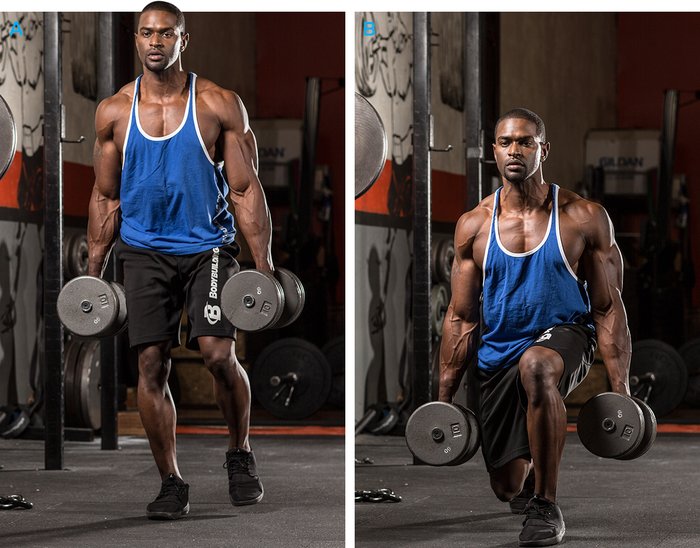
Walking Lunge
KEY TRAINING TIPS
- Keep in mind the goal is to safely cover the distance in as few steps as possible; this will allow you to focus on quality repetitions, not just finishing the set.
- If you don't have space to do 20-yard sets, perform 3 sets for 8-10 reps per leg of alternating reverse lunges.
- Keep your torso upright, and don't allow your forward knee to pass over your toes.
5. Juarez Valley Method Bodyweight Squats
No good leg thrashing would be complete without a great finisher! That is exactly what the Juarez Valley 15 is.
The Juarez Valley method was first presented in an article I wrote for Bodybuilding.com called "Prison Workout: The Jailhouse Strong Routine." The concept is fairly simple: Repetitions are performed in descending order on all odd-numbered sets, but repetitions are performed in ascending order on even-numbered sets. In the middle, they meet! Between each set, take an 8-foot walk, about the length of a jail cell.
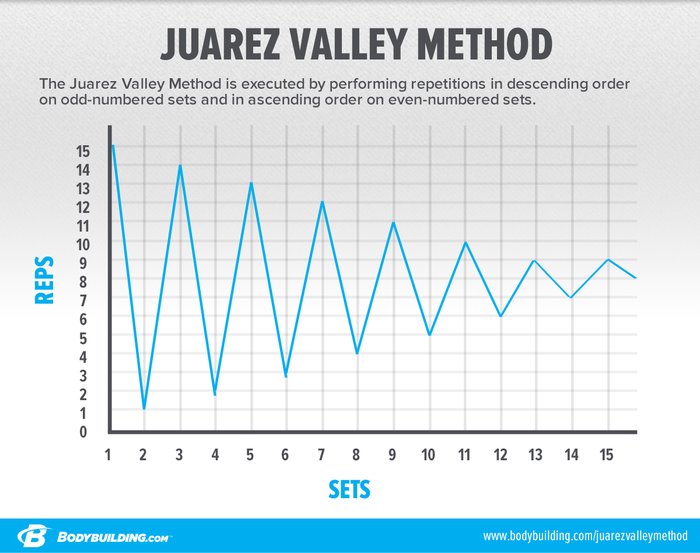
Why use bodyweight squats here? Because it's a simple movement you can do for lots of reps. Just squat below parallel with your hands on your hips or out front for balance, and come back up. The pump you'll have by the end will give you a whole new respect for the simple squat.
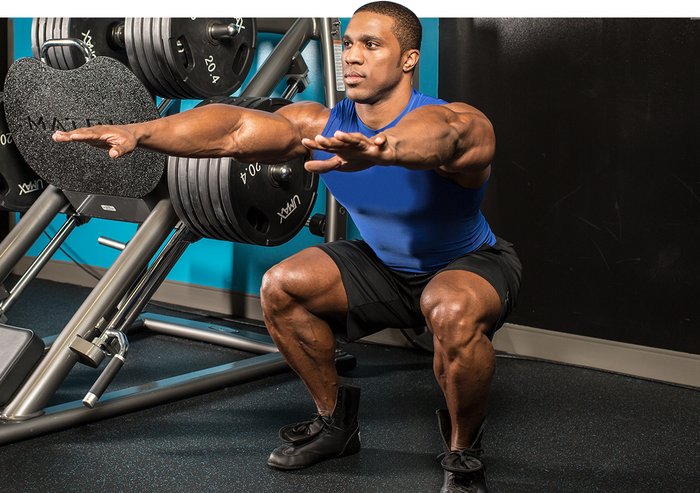
Bodyweight Squat
Key Training Tip
- Perform the routine as fast as possible, and keep track of time. Your goal is to beat your time, not add reps.
- To make this even more intense, pause each rep for one second at the bottom position, and do not lock out at the top. Instead, stop about an inch shy of your legs being locked. Paused reps are intense because they eliminate the stretch reflex. By not locking out, you won't be able to rest at the top, which provides continuous tension throughout the set. Combining both techniques will bring the intensity to a whole new level.
